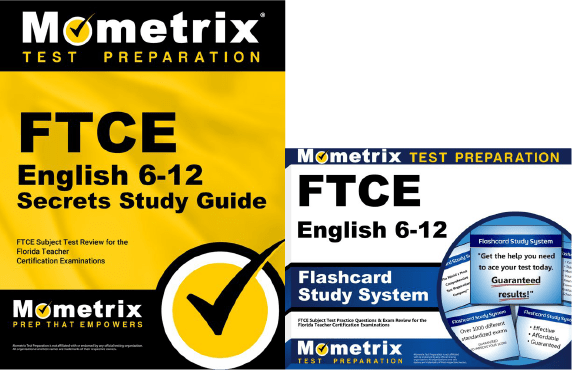If you need help studying for the FTCE English 6-12 test or just want some more information about what the test is like, you’ve come to the right place!
Click below to take a free FTCE English 6-12 practice test!
What’s on the Test?
The FTCE English 6-12 test contains 60 multiple-choice questions and one essay, and the time limit is 2.5 hours.
The exam is split into eight competencies:
1. Effective Use of The English Language at the Postsecondary Level
15% of the exam
- The development of the English language over time
- Standard English grammar, usage, and conventions
- Various sentence types
- Identifying word meanings and pronunciations
- Connotation vs. denotation
- Analyzing word structure and meanings via word parts, etymology, and roots and suffixes
- Interpreting figurative language
2. Communication Skills, Techniques, and Processes
18% of the exam
- Structures and purposes of various forms of writing
- Writing personal and fictional narratives
- Writing an argument with a logical organizational structure
- Writing an expository text that explains and analyzes information from multiple sources
- Improving writing by planning, revising, and editing
- Integrating diverse digital media in written texts
- Developing and refining research questions
3. Literacy Processes and Instructional Practices
15% of the exam
- Analyzing levels of text complexity and readability
- Promoting students’ ability to analyze imagery, semantic and syntactic structures, and diction in texts
- Enhancing students’ ability to determine the meaning of words in context
- Enhancing students’ ability to evaluate how text structure conveys purpose
- Determining students’ proficiency on the reading continuum
- Assessing fluency
- Enhancing the literacy process
4. Knowledge of a Wide Range of Literary and Informational Texts
17% of the exam
- Analyzing how key elements of literary texts add layers of meaning
- The development of universal themes in literary texts
- Comparing and contrasting archetypes in texts
- Understanding how informational text structures and features convey meaning
- Comparing and contrasting how related topics and themes are addressed by different authors
- Evaluating supporting ideas
- Analyzing an author’s reasoning and use of rhetoric
- Comparing multiple arguments on a topic
- Analyzing authors’ use of literary and rhetorical devices to create tone and mood
5. Effective Techniques for Listening, Viewing, Speaking, and Presenting
10% of the exam
- Collaborative techniques
- Active-listening skills
- Presenting information orally with coherent focus and logical organization
- Creating digital presentations that use coherent ideas and a clear perspective
- Using appropriate vocal qualities, nonverbal cues, and pacing
6. Pedagogical Content for Teaching English Language Arts
15% of the exam
- Developing students’ English language skills
- Guiding students in selecting and evaluating valid and reliable information from sources
- Enhancing students’ writing skills
- Providing meaningful feedback on student writing
- Enhancing students’ comprehension and analysis of texts
- Enhancing students’ listening, speaking, presenting, and viewing skills
7. Driving Instructional Decisions within English Language Arts
10% of the exam
- Effectively assessing students’ English language, writing, viewing, listening, speaking, and presenting skills
- Effectively assessing students’ comprehension and analysis of texts
- Determine students’ strengths and needs and adjust instruction accordingly
- Assessing reading performance
- Sharing assessment data with students and stakeholders
8. Evaluating a Student’s Written Analysis of a Literary Text
1 essay
- Evaluating a student’s ability to establish a clear and coherent claim
- Evaluating a student’s ability to support an establish claim by using logical reasoning and elaboration
- Evaluating a student’s understanding of the use of literary elements
- Evaluating a student’s use of logical organizations and purposeful transitions
How to Register
To get started with the registration process, you’ll need to create an FTCE/FELE account on their website. You can then register for the exam via your account.
The exam is split into two parts: the multiple-choice questions and the essay. The testing fee for each part is $75 ($150 if you take both parts together).
How the Exam is Scored
The multiple-choice section of the FTCE English 6-12 test is scored using a scaled scoring method. Here’s how it works:
For every question you answer correctly, you get one point added to your raw score. At the end of the test, your final raw score will be converted to a scaled score. You’ll need a scaled score of at least 200 on this section to pass the exam.
The reason your raw score is converted to a scaled score is because everyone that takes the test is given a slightly different set of questions. Since everyone has a different arrangement of questions, and because some questions are harder than others, converting your raw score to a scaled score ensures a more even playing field.
You’ll also need a total score of at least 5 points on the essay (out of 8 points total) to pass.
FAQs
How many questions are on the FTCE English 6-12 exam?
The exam contains 60 questions and one essay.
What is the time limit for the FTCE English 6-12 exam?
The full exam is timed at 2.5 hours.
What is the passing score for the FTCE English 6-12 exam?
You’ll need to get a final scaled score of at least 200 on the multiple-choice section and at least 5 points on the essay to pass the exam.
How much does the FTCE English 6-12 exam cost?
The testing fee for each part is $75.



 FTCE Study Guide
FTCE Study Guide FTCE Flashcards
FTCE Flashcards